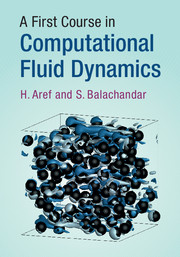Book contents
- Frontmatter
- Contents
- Preface
- 1 CFD in Perspective
- 2 Mappings
- 3 Ordinary Differential Equations: Initial Value Problem
- 4 Spatial Discretization
- 5 Boundary Value and Eigenvalue ODEs
- 6 Methods Based on Functional Expansions
- 7 Partial Differential Equations
- 8 Multi-dimensional Partial Differential Equations
- References
- Index
5 - Boundary Value and Eigenvalue ODEs
Published online by Cambridge University Press: 03 October 2017
- Frontmatter
- Contents
- Preface
- 1 CFD in Perspective
- 2 Mappings
- 3 Ordinary Differential Equations: Initial Value Problem
- 4 Spatial Discretization
- 5 Boundary Value and Eigenvalue ODEs
- 6 Methods Based on Functional Expansions
- 7 Partial Differential Equations
- 8 Multi-dimensional Partial Differential Equations
- References
- Index
Summary
We will begin this chapter with a discussion of two-point boundary value ODEs and then move on to two-point eigenvalue problems. The Blasius equation in Example 1.6.4 is one of the most celebrated two-point boundary value problems in fluid dynamics. Two-point boundary value problems form a challenging class of numerical computations with a wide literature. For an exposition of the theoretical ideas on two-point boundary value problems see Press et al. (1986), Chapter 16, or Keller (1968). Broadly speaking there are two classes of methods for such problems, shooting methods and relaxation methods. Shooting methods are related to integration schemes for initial value problems, while relaxation methods are based on discrete approximations to derivative operators. Thus, we are ready to tackle both these methods. In a shooting method you start from one end as in an initial value calculation using the actual boundary conditions specified at that boundary supplemented with a few other assumed (or guessed) ones which replace the actual boundary conditions of the ODE specified at the other end, and integrate (or “shoot”) towards the other boundary. In general when you eventually reach the other boundary, the boundary conditions there will not be satisfied (in other words you “miss” the target). Hence, you modify your guessed boundary conditions at the starting boundary (“aim” again) and integrate forward (“shoot” again). In this way you have in effect generated a mapping of initially guessed boundary conditions onto errors in matching the actual boundary conditions to be enforced at the other end point. Iterative procedures can now be invoked to converge to the desired value of the boundary conditions at the other end.
In a relaxation method you write the ODE(s) as a system of finite difference equations, guess a solution, and then iteratively improve it by using a root finding procedure for a system of coupled nonlinear equations. This can obviously be a rather formidable task. Often a good initial guess is needed to converge towards the correct answer. Press et al. (1986) give the whimsical recommendation for dealing with two-point boundary value problems to “shoot first and relax later.” As we shall see below, in most problems of interest in fluid dynamics the relaxation method is very powerful, exhibiting rapid convergence towards the correct answer. Furthermore, unlike the shooting method, the relaxation method is easily extendible to boundary value problems in multi-dimensions.
- Type
- Chapter
- Information
- A First Course in Computational Fluid Dynamics , pp. 166 - 209Publisher: Cambridge University PressPrint publication year: 2017



